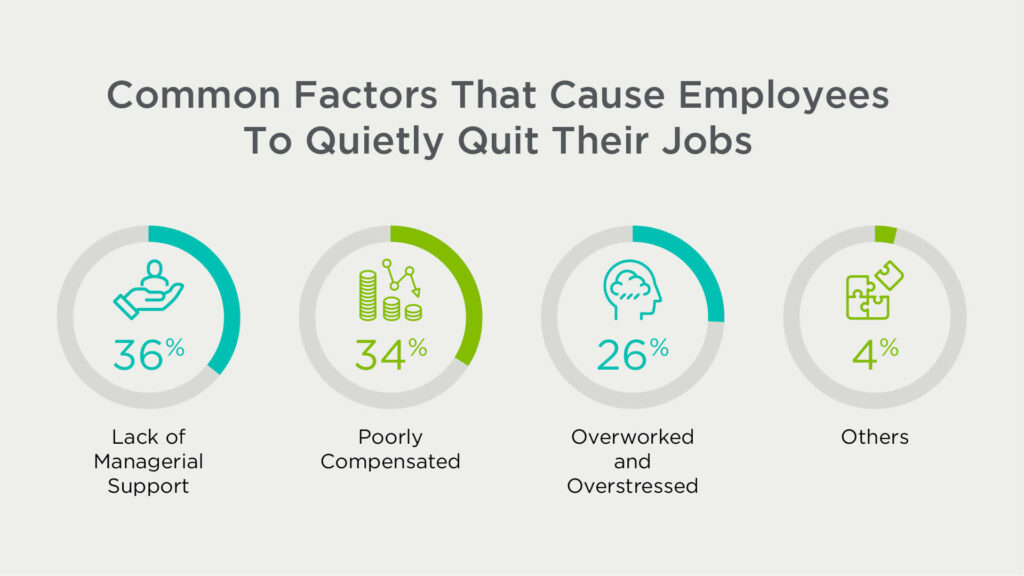
By Foo See Yang, Managing Director & Country Head of PERSOLKELLY Singapore
In recent months, a new term has been trending on the popular social media platform TikTok, called “quiet quitting”. At the same time, in an article by the World Economic Forum, the hashtag #QuietQuitting hit 17 million views on TikTok, and currently trending with 317.5 million views worldwide.
Although not a new concept, “quiet quitting” refers to when overwhelmed and overworked employees resort to only doing the bare minimum to get by at work. Quiet quitters may have no intention of leaving but do not want to participate in the hustle culture. Quiet quitting is seen as a form of employee disengagement, a protest against an imbalanced work-life balance, and a form of noncompliance. While the employee is still fulfilling job responsibilities, they refuse to take on new responsibilities and adhere to the job description that was given. These employees will not go the extra mile and decline new projects or stop volunteering for tasks.
In this article, you will learn more about the causes that lead employees to disengage from work, the effects it has on a company, and what employees and employers can do to prevent employee disengagement.
Recently, we ran a poll on LinkedIn and found out that there are some common factors that cause employees to quietly quit their jobs:

1. Lack of Managerial Support
Over a third (36%) of respondents voted that the reason employees quiet quit is because their manager doesn’t appreciate their effort. Working under a leader who does not support their team will discourage and demotivate them to endure difficulties at work. A caring and considerate supervisor can do much to keep employees motivated and maintain employee engagement. However, they are more likely to withdraw if the supervisors do not support them. When employees feel their managers will not help them, they put up barriers.
2. Poorly Compensated
Around a third (34%) of respondents said that the reason employees quietly quit is because the pay does not justify the effort. So they “only do the work that they are paid for”. Many quiet quitters strongly feel that they are poorly compensated for the effort they put into the work they have to do. And because of that, they decrease their efforts. Often, they have demanded better compensation but have been rebuffed or stalled, or these workers feel that the employer will not meet those demands. Aside from money, the issue is one of respect. If they are not rewarded for their extra work, they feel that the employer does not properly appreciate their sacrifice and effort. This would then lead to workers feeling exploited.
3. Overworked and Overstressed
Around a quarter (26%) of respondents voted that the reason employees quietly quit is because they no longer enjoy their work. This may be due to overwork or overstress. Quiet quitters were once passionate employees, but became overworked and overstressed, leading to employee burnout. Increased workload comes from staff turnover, where other employees must take over the workload before a new employee is hired, rather than the supervisor reducing the workload. This problem causes employees to become exhausted and frustrated.
Here are 3 consequences of quiet quitting in the workplace:
1. Disengagement and Dissatisfaction
The two most common effects are disengagement and an employee’s dissatisfaction with his or her job and workplace. Silent quitters work and cooperate but find no meaning in their work and often feel apathetic.
2. Stagnating Career Growth
To advance professionally, employees must take on new challenges and responsibilities. However, if employees refuse to expand their skills through new challenges and responsibilities, then they are just being stagnant. By doing so, they are only sabotaging their career.
3. Decreased Output
One of the most obvious effects is the reduced work output of a quiet quitter. They may be meeting the minimum requirements for their job. Creativity and collaboration are also affected when an employee decides to quietly quit.
So, what can employees do to quit quiet quitting? Here are 3 tips:
1. Be Efficient
It’s important to achieve a good work-life balance, but we still need to be committed when we are on the job. So, make sure that time is used efficiently during working hours – focus on doing the job well.
2. Take Ownership
Employees need to take responsibility for their career growth and understand why they feel burned out and why they have resorted to quietlyquitting. It is not sustainable if the role does not give the employee a greater sense of purpose and appreciation at work.
3. Communicate With the Employer and Not On Social Media
Before employees express why they are quietly quitting on their social media platforms, it is better to seek an open and honest conversation with your direct supervisor. Take this conversation with the employer as an opportunity to share feedback with them – be very specific. Have an honest and open conversation, but be professional.. However, in addressing the issue of quiet quitters and employee burnout, employers and management must also play their part.
3 ways employers can solve the quiet quitting crisis in their workplace:
1. Make Sure Employees Feel Valued
Employers need to make sure their employees are valued for their contribution, skills, and work. A Gallup Workhuman survey found that in companies where employee recognition is a high priority, employees are 56% less likely to look for a new job. A good start would be to recognise milestones in employees’ lives, such as work anniversaries and birthdays, and celebrate goals achieved or projects completed.
2. Invest in Employee Well-being
Employee well-being and engagement work together. Therefore, employers should prioritise employee well-being by offering support and assistance programmes when employees are struggling. Other well-being benefits could include:
i. Weekly massages;
ii. Office meditation classes during lunch break;
iii. Providing the option of flexible work schedules ;
iv. Encouraging employees to leave on time and take regular breaks and etc.
3. Keeping People Engaged in Their Work
It is important to recognise and value one’s contributions to build employee ownership of their work. Employers should create an open space for their employees to express their ideas and discuss solutions relating to work. Employers need to listen to their employees, especially younger employees, as this not only makes them feel valued but also makes them feel more connected to their work. This is even more important for younger workers as they are looking for a space to be heard.
It can be difficult to detect because some signs may be unintentional or stem from other types of conflict. However, it would be a good start to address changes in your employees’ well-being, performance, and concerns.
Conclusion
Despite being a trend in TikTok videos, Insider found that there are many TikTok users discouraging people from doing so. Remember that communication is key – not social media, but open and professional communication with your employers about your challenges at work. For employers, it is important to continually provide an environment that encourages staff to thrive in the workplace. As for employees, whatever the reason may be, they need to recognise that quietly quitting may hurt their future more than making the move to a new job and a better workplace. Whatever the workforce challenges, look for the opportunity to speak to your leader. There’s nothing to lose but everything to gain in this. Even if the conversation does not work out, you can still look out for other doors of opportunity more suitable for you and your lifestyle. We spend one third of our life at work. It is important to find a role within an organisation that allows you to Work, and Smile.








